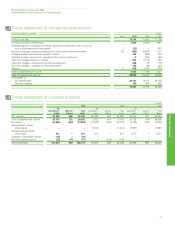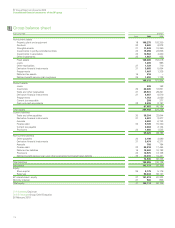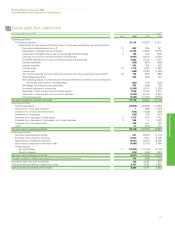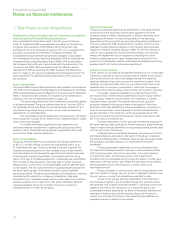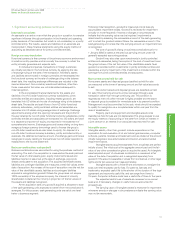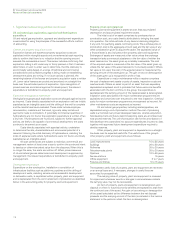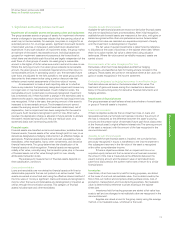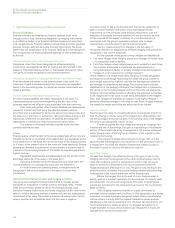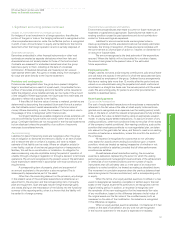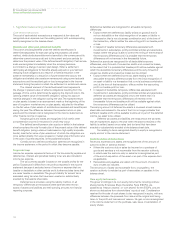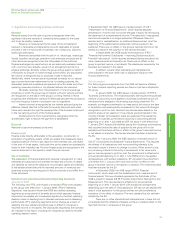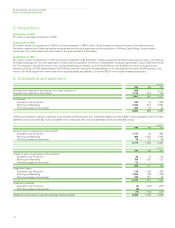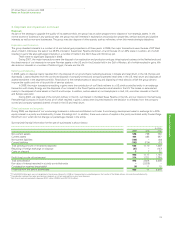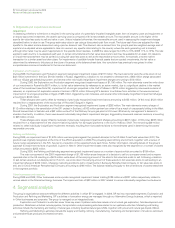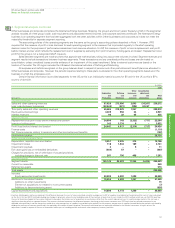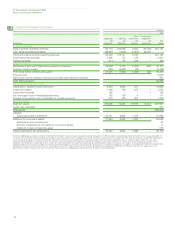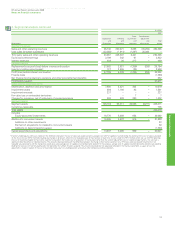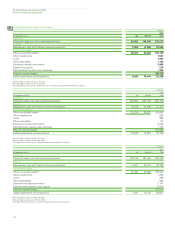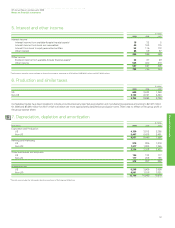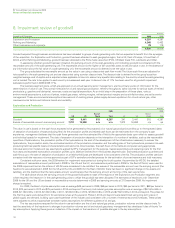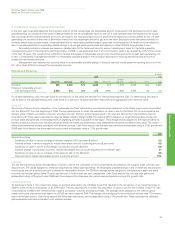BP 2009 Annual Report Download - page 125
Download and view the complete annual report
Please find page 125 of the 2009 BP annual report below. You can navigate through the pages in the report by either clicking on the pages listed below, or by using the keyword search tool below to find specific information within the annual report.
1. Significant accounting policies continued
Revenue
Revenue arising from the sale of goods is recognized when the
significant risks and rewards of ownership have passed to the buyer
and it can be reliably measured.
Revenue is measured at the fair value of the consideration
received or receivable and represents amounts receivable for goods
provided in the normal course of business, net of discounts, customs
duties and sales taxes.
Revenues associated with the sale of oil, natural gas, natural gas
liquids, liquefied natural gas, petroleum and chemicals products and all
other items are recognized when the title passes to the customer.
Physical exchanges are reported net, as are sales and purchases made
with a common counterparty, as part of an arrangement similar to a
physical exchange. Similarly, where the group acts as agent on behalf of
a third party to procure or market energy commodities, any associated
fee income is recognized but no purchase or sale is recorded.
Additionally, where forward sale and purchase contracts for oil, natural
gas or power have been determined to be for trading purposes, the
associated sales and purchases are reported net within sales and other
operating revenues whether or not physical delivery has occurred.
Generally, revenues from the production of oil and natural gas
properties in which the group has an interest with joint venture partners
are recognized on the basis of the group’s working interest in those
properties (the entitlement method). Differences between the production
sold and the group’s share of production are not significant.
Interest income is recognized as the interest accrues (using the
effective interest rate that is the rate that exactly discounts estimated
future cash receipts through the expected life of the financial instrument
to the net carrying amount of the financial asset).
Dividend income from investments is recognized when the
shareholders’ right to receive the payment is established.
Research
Research costs are expensed as incurred.
Finance costs
Finance costs directly attributable to the acquisition, construction or
production of qualifying assets, which are assets that necessarily take a
substantial period of time to get ready for their intended use, are added
to the cost of those assets, until such time as the assets are substantially
ready for their intended use. All other finance costs are recognized in the
income statement in the period in which they are incurred.
Use of estimates
The preparation of financial statements requires management to make
estimates and assumptions that affect the reported amounts of assets
and liabilities as well as the disclosure of contingent assets and liabilities
at the balance sheet date and the reported amounts of revenues and
expenses during the reporting period. Actual outcomes could differ from
those estimates.
Impact of new International Financial Reporting Standards
Adopted for 2009
The following new IFRS, and revised or amended IFRSs were adopted
by the group with effect from 1 January 2009, IFRS 8 ‘Operating
Segments’ was issued in November 2006 and defines operating
segments as components of an entity about which separate financial
information is available and is evaluated regularly by the chief operating
decision maker in deciding how to allocate resources and in assessing
performance. BP’s operating segments did not change as a result of
adopting the new standard and there was no effect on the group’s
reported income or net assets. The disclosures required by the standard
are included in this report, including the measures as used by the chief
operating decision maker.
In September 2007, the IASB issued a revised version of IAS 1
‘Presentation of Financial Statements’, which requires separate
presentation of owner and non-owner changes in equity by introducing
the statement of comprehensive income. The statement of recognized
income and expense is no longer presented. Whenever there is a
restatement or reclassification, an additional balance sheet, as at the
beginning of the earliest period presented, will be required to be
published. There was no effect on the group’s reported income or net
assets as a result of the adoption of this revised standard.
In March 2009, the IASB issued Amendments to IFRS 7
‘Financial Instruments: Disclosures – Improving Disclosures about
Financial Instruments’, which requires enhanced disclosures about fair
value measurements and liquidity risk. There was no effect on the
group’s reported income or net assets. The disclosures required by the
standard are included in this report.
In addition, several other standards and interpretations
were adopted in the year which had no significant impact on the
financial statements.
Not yet adopted
The following pronouncements from the IASB will become effective
for future financial reporting periods and have not yet been adopted by
the group.
In January 2008, the IASB issued a revised version of IFRS 3
‘Business Combinations’. The revised standard still requires the purchase
method of accounting to be applied to business combinations but will
introduce some changes to the existing accounting treatment. For
example, contingent consideration is measured at fair value at the date
of acquisition and subsequently remeasured to fair value with changes
recognized in profit or loss. Goodwill may be calculated based on the
parent’s share of net assets or it may include goodwill related to the
minority interest. All transaction costs are expensed. The standard is
applicable to business combinations occurring in accounting periods
beginning on or after 1 July 2009 and BP will adopt it with effect from
1 January 2010. Assets and liabilities arising from business combinations
that occurred before the date of adoption by the group will not be
restated and thus there will be no effect on the group’s reported income
or net assets on adoption. The revised standard has been adopted by
the EU.
Also in January 2008, the IASB issued an amended version of
IAS 27 ‘Consolidated and Separate Financial Statements’. This requires
the effects of all transactions with non-controlling interests to be
recorded in equity if there is no change in control. When control is lost,
any remaining interest in the entity is remeasured to fair value and a
gain or loss recognized in profit or loss. The amendment is effective for
annual periods beginning on or after 1 July 2009 and is to be applied
retrospectively, with certain exceptions. BP will adopt the amendment
with effect from 1 January 2010 and there will be no effect on the
group’s reported income or net assets on adoption. The revised standard
has been adopted by the EU.
In November 2009, the IASB issued IFRS 9 ‘Financial
Instruments’ which deals with the classification and measurement of
financial assets. This new standard represents the first phase of the
IASB’s project to replace IAS 39 ‘Financial Instruments: Recognition and
Measurement’. The new standard is effective for annual periods
beginning on or after 1 January 2013 with transitional arrangements
depending upon the date of initial application. BP has not yet decided the
date of initial application for the group and has not yet completed its
evaluation of the effect of adoption. The new standard has not yet been
adopted by the EU.
There are no other standards and interpretations in issue but not
yet adopted that the directors anticipate will have a material effect on the
reported income or net assets of the group.
123
Financial statements
BP Annual Report and Accounts 2009
Notes on financial statements


